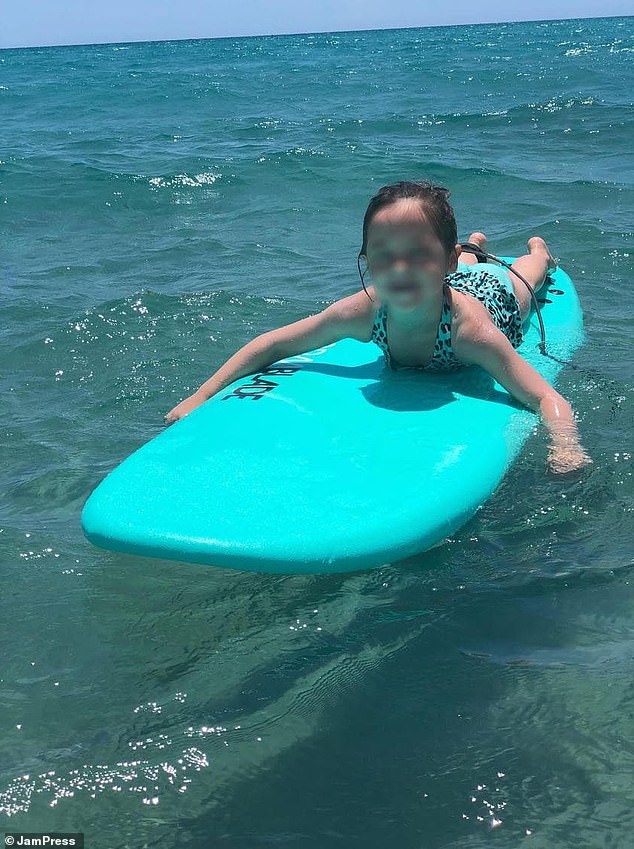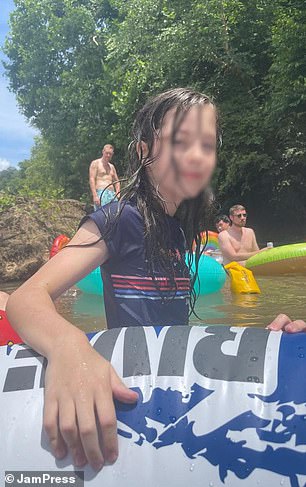Mom warns of deadly dangers of ‘dry drowning’ after daughter is rushed to ICU hours after swallowing swimming pool water
A Florida mother warned of the terrifying dangers of ‘dry drowning’ after her daughter swallowed water from a swimming pool.
Annie Gallagher’s five-year-old daughter was enjoying a summer day when she briefly found herself underwater.‘blinked’ and came up for air coughing.
At first, Ms. Gallagher thought nothing of it. “She seemed fine and wanted to go back to playing, which she did,” the mother of three said.
But later that night, the toddler girl crawled into her mother’s bed and complained that she wasn’t feeling well.
Annie Gallagher’s daughter was only five when she was the victim of a ‘dry drowning’

Mrs Gallagher said that although her daughter seemed fine at first, she later complained of feeling unwell and seemed tired.
“Honestly, my first instinct was to send her back to her room for a good night’s sleep because I was still busy cleaning the house for the next day,” Ms. Gallagher said. “But something in my gut said, ‘Don’t do it.'”
Mrs. Gallagher rushed her daughter to the emergency room, where doctors determined she had suffered from “dry drowning,” a lung injury that occurs when water is inhaled into the airways instead of being swallowed through the digestive tract.
The child had developed a pneumonia called aspiration pneumonia, which occurs when foreign objects or substances enter the airways and irritate them so much that an inflammatory reaction occurs.
When water enters the airways, it blocks access to the airways and makes breathing difficult.
‘[Doctors] It was then that I came to the conclusion that if I had not taken her with me that night, the outcome would have been disastrous,” said Mrs Gallagher.
‘She slowly began to suffocate as she drowned in her own fluid filling her lungs.’
The term “dry drowning” is controversial, however. While some online have said it can be done by swallowing just a small amount of water, other health authorities have said a patient must be fully submerged, which would not make them “dry.”
Dr. Debra Houry, Chief Medical Officer at the CDC, said in May that drowning “can happen to anyone as long as there is water present.”


Mrs Gallagher’s daughter was in hospital for seven days with aspiration pneumonia. Doctors said: ‘If I hadn’t brought her in that night, the outcome would have been catastrophic’
However, the National Drowning Prevention Alliance (NDPA) states that “drowning does not occur until the child or adult has been underwater.”
‘Drowning cannot happen by swallowing water or just playing with it.’
Dr. Purva Grover, a pediatric emergency medicine physician at the Cleveland Clinic, wrote in a hospital blog that dry drowning is not an actual medical term, but that “if you almost drown, symptoms may not occur until after you leave the water.”
Even 12 hours later, you may still have difficulty breathing as your lungs swell with water.
Mrs. Gallagher’s daughter was rushed to a children’s hospital within hours, causing so much distress that the mother passed out and ended up in the emergency room herself.
“I couldn’t believe my child was in critical condition,” Mrs. Gallagher said. “I asked myself, ‘How did this happen?'”
Her daughter responded well to antibiotics, however, and was discharged a week later. “Suddenly, there was life in her eyes,” Gallagher said.
“Just watching my daughter get out of bed or out of her wheelchair allowed me to breathe and laugh with her. She laughed for the first time in a week, and nothing could have been more beautiful than that moment.”
The girl is now 12 and is developing very well. Despite the fright, she still swims regularly.
“I want parents to know that these things happen,” Ms. Gallagher said. “We can’t put our kids in a bubble, unfortunately, but we have to keep living.”
“The best thing we can do is be aware of the safety risks, teach our children and watch them while they are still learning.”
“But most of all, as a parent, trust your instincts. Mine saved my daughter’s life.”
